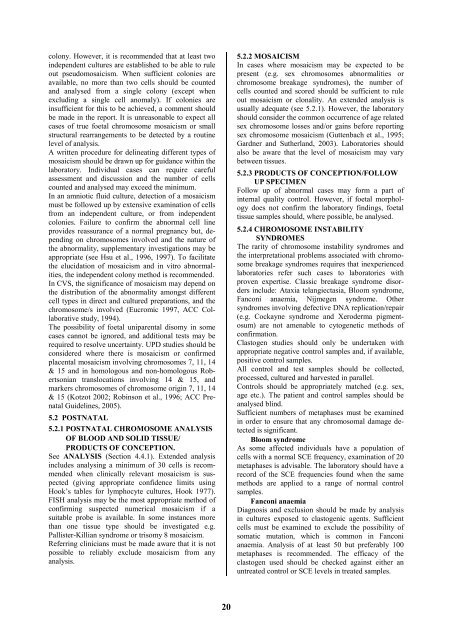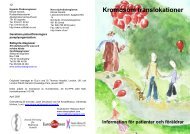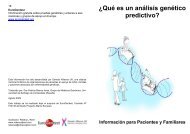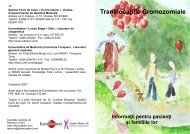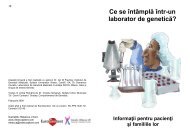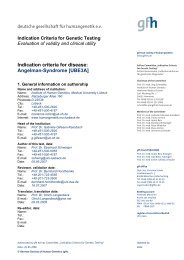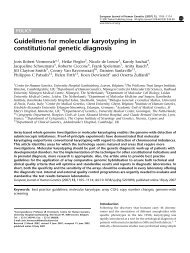Cytogenetic Guidelines and Quality Assurance - EuroGentest
Cytogenetic Guidelines and Quality Assurance - EuroGentest
Cytogenetic Guidelines and Quality Assurance - EuroGentest
You also want an ePaper? Increase the reach of your titles
YUMPU automatically turns print PDFs into web optimized ePapers that Google loves.
colony. However, it is recommended that at least two<br />
independent cultures are established to be able to rule<br />
out pseudomosaicism. When sufficient colonies are<br />
available, no more than two cells should be counted<br />
<strong>and</strong> analysed from a single colony (except when<br />
excluding a single cell anomaly). If colonies are<br />
insufficient for this to be achieved, a comment should<br />
be made in the report. It is unreasonable to expect all<br />
cases of true foetal chromosome mosaicism or small<br />
structural rearrangements to be detected by a routine<br />
level of analysis.<br />
A written procedure for delineating different types of<br />
mosaicism should be drawn up for guidance within the<br />
laboratory. Individual cases can require careful<br />
assessment <strong>and</strong> discussion <strong>and</strong> the number of cells<br />
counted <strong>and</strong> analysed may exceed the minimum.<br />
In an amniotic fluid culture, detection of a mosaicism<br />
must be followed up by extensive examination of cells<br />
from an independent culture, or from independent<br />
colonies. Failure to confirm the abnormal cell line<br />
provides reassurance of a normal pregnancy but, depending<br />
on chromosomes involved <strong>and</strong> the nature of<br />
the abnormality, supplementary investigations may be<br />
appropriate (see Hsu et al., 1996, 1997). To facilitate<br />
the elucidation of mosaicism <strong>and</strong> in vitro abnormalities,<br />
the independent colony method is recommended.<br />
In CVS, the significance of mosaicism may depend on<br />
the distribution of the abnormality amongst different<br />
cell types in direct <strong>and</strong> cultured preparations, <strong>and</strong> the<br />
chromosome/s involved (Eucromic 1997, ACC Collaborative<br />
study, 1994).<br />
The possibility of foetal uniparental disomy in some<br />
cases cannot be ignored, <strong>and</strong> additional tests may be<br />
required to resolve uncertainty. UPD studies should be<br />
considered where there is mosaicism or confirmed<br />
placental mosaicism involving chromosomes 7, 11, 14<br />
& 15 <strong>and</strong> in homologous <strong>and</strong> non-homologous Robertsonian<br />
translocations involving 14 & 15, <strong>and</strong><br />
markers chromosomes of chromosome origin 7, 11, 14<br />
& 15 (Kotzot 2002; Robinson et al., 1996; ACC Prenatal<br />
<strong>Guidelines</strong>, 2005).<br />
5.2 POSTNATAL<br />
5.2.1 POSTNATAL CHROMOSOME ANALYSIS<br />
OF BLOOD AND SOLID TISSUE/<br />
PRODUCTS OF CONCEPTION.<br />
See ANALYSIS (Section 4.4.1). Extended analysis<br />
includes analysing a minimum of 30 cells is recommended<br />
when clinically relevant mosaicism is suspected<br />
(giving appropriate confidence limits using<br />
Hook’s tables for lymphocyte cultures, Hook 1977).<br />
FISH analysis may be the most appropriate method of<br />
confirming suspected numerical mosaicism if a<br />
suitable probe is available. In some instances more<br />
than one tissue type should be investigated e.g.<br />
Pallister-Killian syndrome or trisomy 8 mosaicism.<br />
Referring clinicians must be made aware that it is not<br />
possible to reliably exclude mosaicism from any<br />
analysis.<br />
20<br />
5.2.2 MOSAICISM<br />
In cases where mosaicism may be expected to be<br />
present (e.g. sex chromosomes abnormalities or<br />
chromosome breakage syndromes), the number of<br />
cells counted <strong>and</strong> scored should be sufficient to rule<br />
out mosaicism or clonality. An extended analysis is<br />
usually adequate (see 5.2.1). However, the laboratory<br />
should consider the common occurrence of age related<br />
sex chromosome losses <strong>and</strong>/or gains before reporting<br />
sex chromosome mosaicism (Guttenbach et al., 1995;<br />
Gardner <strong>and</strong> Sutherl<strong>and</strong>, 2003). Laboratories should<br />
also be aware that the level of mosaicism may vary<br />
between tissues.<br />
5.2.3 PRODUCTS OF CONCEPTION/FOLLOW<br />
UP SPECIMEN<br />
Follow up of abnormal cases may form a part of<br />
internal quality control. However, if foetal morphology<br />
does not confirm the laboratory findings, foetal<br />
tissue samples should, where possible, be analysed.<br />
5.2.4 CHROMOSOME INSTABILITY<br />
SYNDROMES<br />
The rarity of chromosome instability syndromes <strong>and</strong><br />
the interpretational problems associated with chromosome<br />
breakage syndromes requires that inexperienced<br />
laboratories refer such cases to laboratories with<br />
proven expertise. Classic breakage syndrome disorders<br />
include: Ataxia telangiectasia, Bloom syndrome,<br />
Fanconi anaemia, Nijmegen syndrome. Other<br />
syndromes involving defective DNA replication/repair<br />
(e.g. Cockayne syndrome <strong>and</strong> Xeroderma pigmentosum)<br />
are not amenable to cytogenetic methods of<br />
confirmation.<br />
Clastogen studies should only be undertaken with<br />
appropriate negative control samples <strong>and</strong>, if available,<br />
positive control samples.<br />
All control <strong>and</strong> test samples should be collected,<br />
processed, cultured <strong>and</strong> harvested in parallel.<br />
Controls should be appropriately matched (e.g. sex,<br />
age etc.). The patient <strong>and</strong> control samples should be<br />
analysed blind.<br />
Sufficient numbers of metaphases must be examined<br />
in order to ensure that any chromosomal damage detected<br />
is significant.<br />
Bloom syndrome<br />
As some affected individuals have a population of<br />
cells with a normal SCE frequency, examination of 20<br />
metaphases is advisable. The laboratory should have a<br />
record of the SCE frequencies found when the same<br />
methods are applied to a range of normal control<br />
samples.<br />
Fanconi anaemia<br />
Diagnosis <strong>and</strong> exclusion should be made by analysis<br />
in cultures exposed to clastogenic agents. Sufficient<br />
cells must be examined to exclude the possibility of<br />
somatic mutation, which is common in Fanconi<br />
anaemia. Analysis of at least 50 but preferably 100<br />
metaphases is recommended. The efficacy of the<br />
clastogen used should be checked against either an<br />
untreated control or SCE levels in treated samples.


